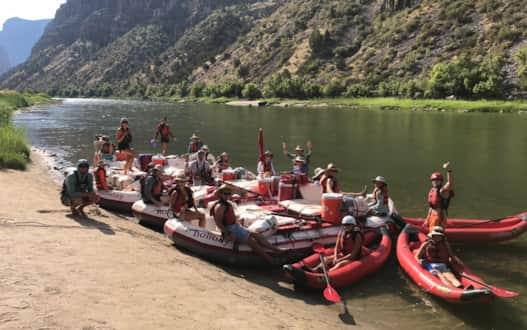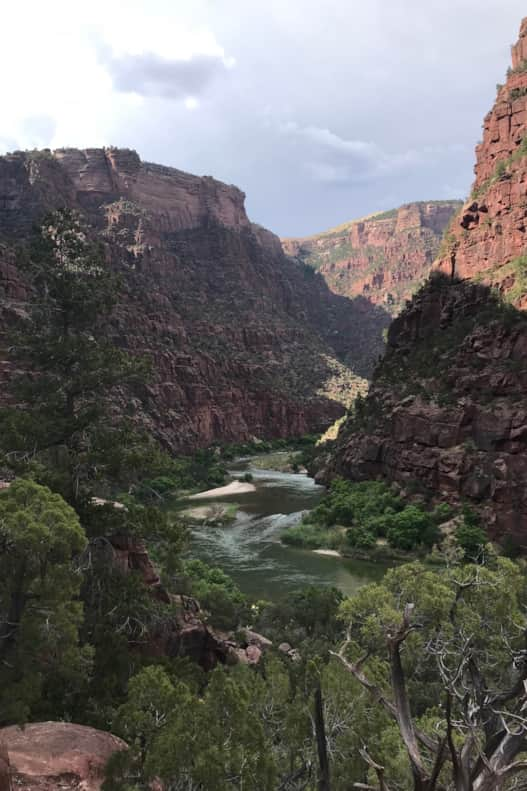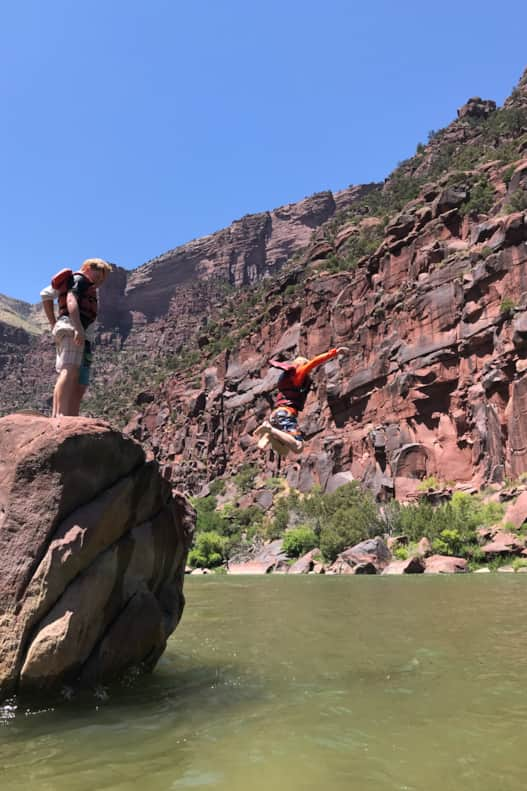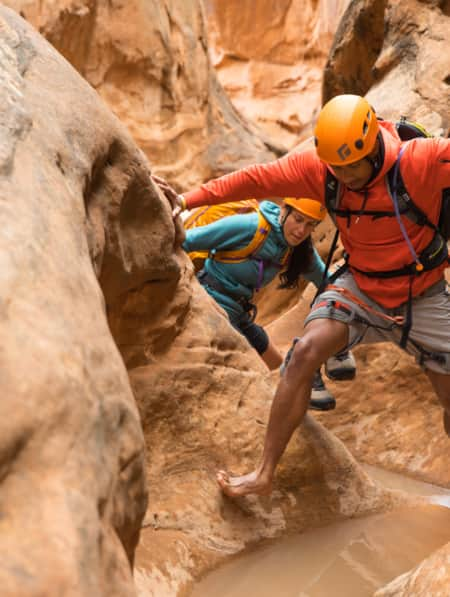Remote Adventure on the Green River
150 years after John Wesley Powell mapped the Green, experience the same solitude and scenery with plenty of (safer) spills and thrills


For the best — and perhaps the most unique — experience, go with a guide.
Photo: Heather May
On May 24, 1869, John Wesley Powell and a band of nine daring explorers embarked on what’s been called one of the greatest adventures in American history: A three-month trip to investigate a region of the United States he called “the great unknown.”
They set out to map the Green and Colorado Rivers through the Grand Canyon, not knowing what danger they’d face in the form of plunging waterfalls, killer rapids or dead-end canyons. All on wooden rafts they rode backward.
It’s impossible not to think of Powell as my family stands on the banks of the Green River as we are about to start our own adventure, some 150 years later. Ours is a four-day trip through the best part and most iconic part of Powell’s trip: A four-day ride starting at Lodore Canyon in what is now Dinosaur National Monument. The canyon’s name was given by Powell, as were several rapids with ominous names like Disaster Falls and Hell’s Half Mile that dashed one of their boats on the boulders, sinking it, much of their food and nearly drowning some of the crew.
We will have our own adrenaline-fueled adventure on our trip with Holiday River Expeditions, a Utah-based company that has been guiding since the 1960s. But with plentiful provisions and no risk of going overboard — except on purpose. Still, we will be stepping back in time to experience very nearly the same breathtaking scenery Powell and his crew mapped.
“That’s one of the cool things about the preservation of these wilderness canyons: They are very much the same kinds of wilderness they went through 150 years ago,” says Lauren Wood, Holiday’s trip director. “These places are still intact. Lodore is one of the most biodiverse areas in the whole state.”
War paint and a cream-colored gown
When we wake up on the second day of our trip, we are greeted with an unexpected sight: Our river guide, who goes by Sherpa, has applied white polka dots along his cheekbones and squiggled green and purple designs on his cheeks.
He’s put out the face paint crayons for my husband and I and our 11-and 9-year-old sons to do the same. In the shadow of soaring canyon walls made of dark red sandstone, we gamely play along and apply our own war paint.
Today, we will be facing Powell’s Triplet Falls and Hell’s Half Mile, two sets of rapids that will roar like thunder and send us bumping and splashing through boulder gardens that make running the Green one of the most unique outdoor adventures in the western United States.
As we approach the challenging rapids later in the day, Sherpa offers another surprise: Just as we are about to descend into the raging spectacle he covers his head in a cheetah-print shower cap and reveals a full-length cream-colored gown. He wets his hands, grabs the oars and puffs out three quick breaths as if to tell us that the dangers on the Green are real. But we are going to have fun facing them.
Going With the Flow (and without screens)
We’ve come in search of screen-free family time with Holiday River Expeditions — a Utah-based company that has been guiding since the 1960s — and one of several great choices. (Read: Five Reasons to Hire a Guide to Run Utah’s Rivers.) In our search for the unexpected, we are rewarded with otherworldly rock formations, vast mountain ranges and rainbow-colored dunes.
Our days are spent immersed in a rare and fragile landscape that can only be encountered via this ancient river. At night, unparalleled views of the cloudy belt of the Milky Way enchant us. And throughout the trip, we have countless silly moments splashing and swimming in a clear, emerald green current once known as the River of Good Fortune.

Cliff walls abruptly rise up from the water.

Camping on the sandy beach, the band of sun on the cliffs slowly turns dark.
"It’s an incredible way to experience a place: no cell phones, no distractions. We are in the moment as we hang on."
It’s an incredible way to experience a place: no cell phones, no distractions. We are in the moment as we hang on through the rapids, seek escape from the heat in the water, try our hand at rowing, take our meals on the river's beaches, and fall asleep to the sound of its current.
Jan Wood, whose parents founded Holiday River, has traveled down Lodore countless times, often as a guide. On this trip, she’s a guest and tells us that the river always transforms her. “When I step on the boat, I’m immediately at peace and in the groove of being on the river [through] the connectedness I feel to the natural world [and being] able to use your mind in completely different ways.”
Later, we will spy her sitting on the bank, painting the canyon wall scene with watercolors she’s brought.
With literally nowhere else to go but with the flow, the river offers plenty of time to reflect. In the words of the first river runner to solo the Green, our job is to “listen, look think and wonder about the grandeur that surrounds [us] rather than to listen and talk of war, politics and football scores.”
The monument we explore is named for a treasure trove of dinosaur remains found in 1909 just miles from our final take out. The plated Stegosaurus, long-necked Apatosaurus and meat-eating Allosaurus died 150 million years ago, and their graveyard is on display at Quarry Exhibit Hall near Vernal, which contains one of the greatest concentrations of dinosaur remains in the world.
But for many, it’s the water, and the canyons they carved millions of years ago, that also defines the monument. Indeed, the original 80-acre monument was expanded to 211,000 acres precisely to protect the grandeur and geological value of the water and the rugged canyons.
Instead of shuttling through other crowded national parks with the rest of the summertime mobs and shuffling in line on well-worn trails, we practically have this portion of Dinosaur National Monument to ourselves.
It’s meant to be this way: The National Park Service limits river permits to keep it wild, with moments of solitude in untrammeled spaces, similar to how it looked when it was first explored by white men in the early 1800s. The only other people we see are the few other parties also running the Green and some lone fly fishermen.
Our group includes 20 guests floating atop four 17-foot inflatable rafts, traveling 44 miles down river, dropping a total of 600 feet from launch to take out. On the first day, we meet in Vernal at 7 a.m., and after we gather in a circle to share our names and favorite parks we caravan three hours away to the boat launch at an imposing-sounding place that could feature in HBO’s Game of Thrones: The Gates of Lodore.
The drive is deceiving. Endless miles of flat desert plains and sagebrush eventually yield to a view of our destination in the distance: a mountain range you might pass without a second glance. But once we arrive and the guides launch the rafts, it feels as if we’ve come upon a tucked away treasure. With a few pushes of the oars, we leave behind a flat lowland where the river is shallow and wide and the hills are far away. We enter the canyon “gates” where the river cuts through the Uinta Mountains and we crane our necks as the cliff walls of Lodore Canyon abruptly rise up from the water.

This river canyon is considered by many to be one of the most beautiful in the country.
Photo: Heather May
This river canyon is considered by many to be one of the most beautiful in the country. It is built of what looks like stacked blocks of sandstone that, depending on the light, look rose, merlot or blood red. It makes the green shades of the river, along with the grasses and juniper and pinyon trees growing on the banks and in the cracks and tops of the walls, all the more striking in contrast.
“The canyon is so magnificent — tall and steep, imposing in a way,” says Justin Malloy, the head guide, as we float down the river. “You feel you’re in a cathedral in a way.”
Dinosaur National Monument has been called one of the quietest place in the country, with noise levels registering below a whisper. Away from the thunderous rapids, I can believe it as we listen to the dip of the oars, the tinkling of water over smaller rocks and the descending trill of a canyon wren. We find ourselves utterly relaxed, laying on the edge of the boat. Our guides point out herons and osprey overhead, bighorn sheep on the banks and the tiger swallowtail butterflies flapping their black and yellow wings back and forth across the water.
Educating guests is a key part of Holiday River Expeditions’ mission, so that we will want to protect what we’ve experienced. At another point in the trip, the guides pointed out 1,000-year-old petroglyphs and explained about the Fremont people who left them.
The first challenge, Powell’s Disaster Falls remains a class 3 rapid. Sounds scary to me, so I make sure the boys are holding the ropes tightly like we’ve been taught. Those in the front get splashed, but our other guide, Tim “T-bird” Burdick, finds the easy slots through the boulders and we experience a gentle ride floating on top of the rocks.
Embracing Life on — and in — the River
I held off on a full river baptism on the first day. I see my fellow campers washing in the river, but they’re shivering. And no wonder: The Green has glacial origins in Wyoming.
I’m set on waiting for the right moment, not realizing it’s not up to me.
Instead, we set up our tents on the sandy beach and sit in the camp chairs, watch the band of sun on the cliff slowly turn dark and seek out the first stars of the night. By the time we head for bed, serenaded by an orchestra of crickets and the sound of water, the river of sky above the canyon is awash in stars, this view its own kind of endangered species in light-polluted cities and towns.
On our way to the rapids that highlight our second day, the guides beach the boats to scout their route through the rocks. After our guide Sherpa gets psyched up in his makeup, the front of our raft heads down and we are off. In a blur, Sherpa rows and avoids boulders clogging the channel on one side and then the other. He moves down tongues of the river and his oars glance off large boulders.
“We did it!” he exclaims, as we dock the raft alongside our group’s. The guides may have navigated this river dozens of times, but it’s still a thrill.
In the face of rollicky, bumpy wet ride, I find myself bracing my legs on the front of the raft. But we exit the rapids safely with a delirious thrill.
Feeling brave after facing the danger and coming out just fine, I later try my hand at paddling in one of the inflatable kayaks — known to river runners as a ducky — through some mild rapids. I know I need to aim left of the rock that’s approaching, but instead, I end up on top of the rock, which tips me out of the kayak into the cold rush of water. Full of adrenaline I hop back in and make my way to our second campground.
From here on out, I’m all in: It’s a thrill to be submerged, even in the evening. Every chance we get, we find spots to swim upstream like we’re in an infinity pool, to float downstream on our backs, to jump off rocks. The reward after a 2.75-mile hike up from our campground along Jones Hole Creek through cathedrals of soaring sandstone is what our guides call Butt Dam Falls. T-bird sits on a rock ledge above the waterfall and lets the water build up. We take turns leaning against the moss trail left on the wall and wait for the water’s release. It’s freezing and thrilling and makes us all laugh. My 11-year-old does it three times.
"By the time we head for bed, the river of sky above the canyon is awash in stars, this view its own kind of endangered species in light-polluted cities and towns."

At long last, becoming river rats.
Photo: Heather May
Unlike in Powell’s day, when the river levels would have been hellishly unpredictable, the speed and depth of the river is controlled by releases from Flaming Gorge reservoir.
Those reserves of water allows us to be on the Green in early July (it can be run from May to September) but not the other river in the monument, the Yampa. The Yampa is the last major undammed tributary of the Colorado River system. It depends on the runoff from snowmelt, so river trips end in early in the season because the water is too low.
We met up with the Yampa on our third day. The two rivers converge at a serene and stunning point in the journey — the face of Steamboat Rock, named for the hulking shipping vessel it resembles, if a steamboat was 900 feet tall. The prow of the pale sandstone, with vertical stripes of black dipping toward the water, points to a bank of cottonwood trees and a downward sloping bluff across the river. Some guests yelled to see if Echo Canyon, as this spot is named, would answer the call. Others skipped rocks or watched the shadows of sparrows flit and flutter on the sandstone face.
After the Yampa joins the Green, the two make a U-turn around Steamboat and flow past a fault in which the orange and grey spine of the mountain rises from the water and curves up like an ocean wave frozen in time.
The final day offers a truly grand finale through Split Mountain Canyon, with Moonshine and S.O.B. rapids and their large rocks and small drops and promises kept that we will get wet. (And for visitors looking for a shorter trip, Split Mountain is the site of an excellent daily trip.)
By the end of our journey, I realize I can’t make our sons appreciate the views, that we are in the land of long ago oceans and dinosaurs, that we’ve traveled through a billion years of geologic history. But they’ve learned on their own the joy of swimming in water on a hot day, of jumping off a rock the size of an elephant into the river, of making mud piles and standing under a waterfall.
After all, as Sherpa tells them when the trip is over and we are about to depart from Vernal, “you’re river rats now.”

How to Find a Guided Outdoors Experience
You might not be a pro climber, camper or explorer, but Utah’s diverse collection of outdoor guides has all of the expertise you need to have an adventure worth getting stoked about.









